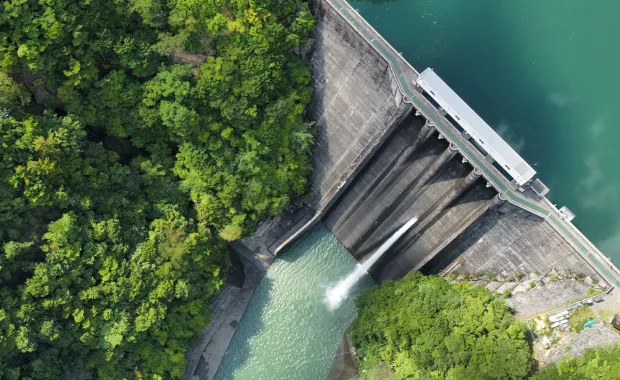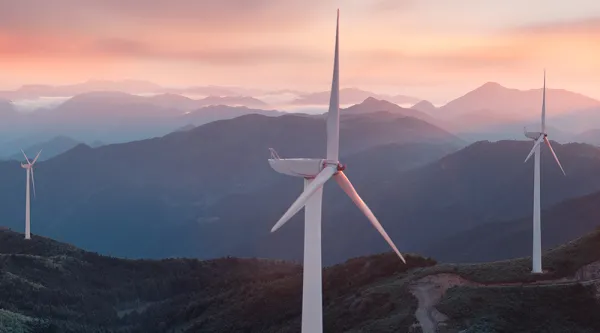In part two of the Energy Transition Talks discussion between Eurelectric’s Head of Energy Policy, Climate and Sustainability Paul Wilczek and CGI expert Peter Warren, they turn their focus to the opportunities and challenges of localized energy production, the role AI and new technologies play in balancing decentralized power grids and the long-term benefits of decarbonizing and electrifying the energy sector.
Catch up on part one of the conversation.
The renewable energy surge in Europe
Localized energy production and renewable energy is increasing, as energy and security of fossil fuels coming from more volatile regions face increased disruption and costs. Referencing various studies, projections and European Commission publications, Paul indicates that the deployment of renewable energy sources—particularly solar photovoltaic (PV) and onshore/offshore wind power—is expected to experience a massive surge in Europe across all scenarios.
Eurelectric projections indicate that solar and wind power generation will triple or even quadruple by 2040 and 2050.
As Paul explains, this rapid growth in localized renewable energy production offers several advantages:
- Homegrown electricity production: Europe will have a significant portion of its electricity generated domestically, reducing dependence on imports from potentially unreliable foreign partners, thereby enhancing energy security and supply reliability.
- Decarbonization: Renewable energy sources like solar and wind are carbon-free, contributing to the decarbonization of Europe's electricity sector.
- Price predictability: Domestically produced renewable energy can provide more predictable and stable power prices, reducing volatility associated with imported energy sources.
At the same time, he points out, the projected surge in renewable energy deployment presents challenges too: such rapid growth also necessitates addressing the challenges of variability and the need for substantial investments.
The role of AI and new technologies in managing the energy system efficiently
While traditional energy generation like hydroelectric power will continue to play a role, Peter says, the major shift towards renewable but variable sources like wind and solar impacts not just the volume of energy produced, but also the frequency and grid balancing when the sun shines or wind blows. New technologies, he suggests, will play a supporting role in transitioning to distributed energy resources (DER) production.
Paul agrees, suggesting that a decade ago, few predicted the current dominance of wind and solar energy. Technologies like biomass and geothermal were expected to have a bigger role. However, the plummeting costs of wind and solar have made them the clear winners for now.
That said, other technologies like geothermal, hydropower upgrades, and efficiency gains across all sources could still play an increasing part in the decarbonized energy mix, along with some dispatchable sources like nuclear in certain regions.
For Paul, the key breakthrough is managing the system—the variability and flexibility-- to integrate all these variable renewable sources cost-effectively. This is a complex, multi-layered challenge involving:
- Smart grid management by operators
- Engaging consumers with smart charging, dynamic pricing etc.
- Affordable energy storage solutions
- Market-based orchestration rather than top-down control
Managing the energy system efficiently, Peter adds, requires high-quality data at a large scale and pace, which presents an opportunity for new technologies like AI to assist with prediction, balancing, and decision-making.
The key challenges include predicting when wind and solar energy will be available, forecasting energy consumption patterns, and understanding electric vehicle (EV) charging behaviors. However, Paul says, this should be viewed as an opportunity rather than a challenge, as some regions in Europe have successfully integrated significant amounts of variable renewable energy sources into their systems.
Preparing for the flexible future of energy
To prepare for the upcoming changes in the energy sector driven by the transition to renewable sources, Paul suggests organizations should focus on embracing flexibility as a core principle and should:
- Understand the various flexibility sources (grid, demand-side, power production, markets) and related data
- Explore opportunities to benefit from flexibility, whether from demand-side management, market participation, or grid services
- Adopt flexible and smart technologies like smart meters, electric vehicles (EVs) as mobile batteries, and vehicle-to-grid (V2G) systems
Focus on long-term benefits, innovation and partnerships
While the energy transition will induce significant upfront costs, it's essential for organizations to consider the long-term benefits and actively explore innovative solutions and partnerships to leverage emerging opportunities. As Paul recommends:
- Don't focus solely on the costs; also consider the benefits of decarbonization, electrification and energy efficiency
- Assess the potential cost of inaction and reliance on external energy sources, as highlighted by the Ukraine crisis
- View the expenditures as investments rather than just costs, as they will yield long-term savings and benefits
- Collaborate with technology providers and automakers offering V2G solutions, like the partnership between a US solar company and Ford for the F-150 Lightning
- Engage with energy storage providers and explore business cases for energy storage systems (ESS) to increase renewable energy utilization and grid flexibility
- Participate in regulatory and policy discussions to shape frameworks that enable ESS adoption and flexibility services
Ultimately, managing the complexities of the evolving energy landscape requires innovative data, technologies, and a collaborative ecosystem mindset that transcends traditional industry boundaries. Embracing these opportunities and digital innovations can drive the energy transition forward.
Listen to other podcasts in this series to learn more about the energy transition
Read the transcript:
- 1. Europe pivots to local renewables for energy independence
-
Peter Warren
Hello everyone, welcome to part two of my great conversation with Paul Wilczek from Eurelectric. Paul, do you want to reintroduce yourself for the audience?
Paul Wilczek
Hi, sure, Peter. I'm Paul Wilczek. I'm the Head of Energy Policy here at Eurelectric, the association of the power sector of the power utilities in Europe, based in Brussels.
Peter Warren
Thanks very much. And just to give everyone a summary for the first section, we talked a lot about the shifting drivers for electrification, what's moving forward, everything from vehicles right through to EVs, and infrastructure.
In the second part, we wanted to continue to look at more localized energy production, the aspects of renewable energies and how they're going to play a role here, because—I think you touched on it in your last section there, Paul—energy and security of traditional fossil fuels coming from regions that are more volatile and disruptions and cost is going to go up. That's one factor, but one of the things we can do is start to make energy more locally and more within our own control. Do you want to kick it off with your thoughts on that and we'll dive into the next piece?
Paul Wilczek
Yeah, so we have seen this in various studies, projections, and European Commission publications that the rollout of renewable energy—particularly solar PV and wind onshore and offshore—is going to take off massively in all the scenarios. We have seen this ourselves in our scenarios: solar and wind power basically tripling, quadrupling up to 2040 and 50, which is great, because we have a lot of homegrown electricity production, which is decarbonized in Europe. We are not dependent on imports, on volatile imports from unreliable partners from outside of Europe. This is about security of supply. This is about predictability of power prices.
But it causes some challenges too, because the investment cost is massive that we have to do, but we need to invest anyway, right? And the nature of the technologies that are going to be very dominant in the future being wind and solar is variable output and this variability needs to be addressed. So, we see also quite a shift in the production pattern of electricity in general.
- 2. Leveraging new technologies for balancing renewable, decentralized power grids
-
Peter Warren
You mentioned in the first part that a lot of the infrastructure today that we consider, where it was traditional generation—might have been hydroelectric, might have been some other form—where it was coming from point A and going to point B. That's still going to continue for a large part with nuclear, as it's considered part of the decarbonization. But the renewable energy and the volatility is impacting things, energy frequency, not just the volume and energy when the sun comes out or the wind blows, but also balancing the grid. How do you see new technologies coming in to help with all of this as we move to more of a distributed energy production?
Paul Wilczek
Yeah. New technologies—look at just 10 years ago; nobody would have predicted such a dominance of wind and solar only. We would have predicted maybe biomass would play a bigger role, maybe other technologies like geothermal would play a bigger role, but nobody has predicted that variable technologies like wind and solar would take off so massively and go down in their production costs also so considerably. You can't beat technology costs. So, everything will depend on technology costs in the future. I don't know which ones will win. What is clear is that wind and solar are winning right now. Let's see whether geothermal, for example, will play a bigger role than it does right now. How far can we go in hydropower as well and repowering all the hydropower stations that we have right now? There's a lot of efficiency gains perhaps in all of these technologies.
What is clear is that all this power generation needs to be decarbonized. And of course we need some dispatchable generation as well for system security. So, it's hydropower, it's biomass, it's nuclear in certain regions of Europe that plays a very dominant role. It’s all part of the puzzle. And the breakthrough will be of course in managing the system, I believe, because we need to manage the system in a very different way right now. So, it's about the variability and the flexibility that you need to manage this variability and your ability as a system operator, as a consumer, as a market orchestrator to bring this all together in a cost-efficient way. It's complex, it's many layers: You want to take the public with you because you have people that have an electric vehicle, and they want to charge it in a smart way. You have some people that want to have dynamic tariffs. What can you offer? How far can you bring the demand side into the place? What sort of storage technologies will you have at acceptable costs in the future as well to play a role?
So, it's really complex, but it can work. That's basically the main point. Some technologies, it's about managing the system, I would say. It's about managing the system smartly and being able to orchestrate all of that in a probably market -based form because you can't beat the market after all and finding cost -efficient solutions after all rather than having it orchestrated from a top -down perspective who should do what and when that will enable this energy transition in a cost-effective way.
- 3. AI and new technologies unlock predictability to optimize energy transition
-
Peter Warren
Yeah, what I selfishly love about all of that problem is that it's all going to require quality data at pace and scale, which is something we love to do as a company. But it's also, I think, a lot of room for new technologies. We talked about technical technologies, but even AI, other technologies coming in to help that prediction, the balancing, and moving forward to give people the abilities that better decisions at pace and scale. I think that's going to be the big challenge.
Paul Wilczek
Yeah, predictability, when is the wind going to blow? When is the sun going to shine? Who's going to consume?
when and how much, what sort of electric vehicle charging patterns out there. I mean, the possibilities are vast. Also for new businesses and data providers, there will be much more data out there basically that can be used to optimize the system. But it's an opportunity. I mean, let's look at it as an opportunity rather than a challenge.
And we see some success stories; look at some parts of Europe that have huge amounts of decarbonized electricity going on in the system, also variable output based, like Denmark, for example. So it can work, it can technically work.
Peter Warren
Yeah, I totally agree with you. And it's, it's, I think we have to look beyond, I think people have traditionally looked in silos, but this is really something that's happening now. I was just on a call earlier today, uh, where it was, uh, people are not staying in their same swim lanes. Manufacturers are in the energy industry. Uh, car manufacturers are a key component you mentioned about the charging. They might have the data, but the utility needs it. Uh, looking across the whole ecosystem, uh, beyond just maybe our particular part is going to be what's going to be required and connecting to these other parts. As you mentioned, opportunities for new companies to come in here, startups and a variety of different things. I guess that's all really getting us to the energy transition and readiness for it.
- 4. Flexibility is crucial for the future energy transition
-
So what would be your thoughts for folks on how to get ready for this change themselves, either as an organization or a part of the energy companies?
Yeah, I would say the key word in business and basically how the system will work in the future is flexibility. So flexibility will be the key. You have flexibility sources and related data to it from the grid, from the demand side, from power production, from the markets. Everything will be running in a much more flexible way. It just has to be because the system will be much more variable in the future. So as long as you on tap and get your wits around flexibility and what does it mean for me as a business and what sort of opportunities do I get by somehow yielding benefits out of flexibility, be it from the demand side, the market side or the grid side.
There is something to be made there. There's something to be done. And the possibilities are quite endless. The flexibility sources will also enlarge. There will be flexibility from e -mobility because if you look at it, every electric vehicle is a battery on four wheels. So smart charging, smart meters, we will have smart meters everywhere.
So just brace yourself for this keyword flexibility. There is the business, I believe, in the future.
To some, that's a scary word, flexibility, because it's been very linear for a long time. But I think that's a good heads up. Vehicle2Grid has a great opportunity there. The Ford Lightning, we have one company partner that actually does that in the States. They are a solar company in the US, and they actually have a partner with Ford. So if you buy one of their Ford Lightnings, you can actually charge it and dispense to your home. So I think people are starting to move into that direction and be very innovative in these points.
- 5. The energy transition requires upfront investments but offers long-term benefits and savings
-
As we just sort of get to time here, I'll give you the final word here, Paul, and I really do appreciate your time and expertise on all these things. What would you leave the audience with as a closing comment?
Yeah, I would say the energy transition as it looks right now is going to induce a lot of costs, but you need to look at the benefits that you got of that. So I feel that policymakers, stakeholders, players in the power sector look at the costs more than at the benefits, get scared because there's a lot of costs that there's no doubt about it. Things can get more expensive in the first place, but it will pay off. So don't look only at the cost, look at the benefits that are out there for you when you really decarbonize and electrify the energy sector. Look at the energy efficiency, look at the price that we pay right now, actually. What is the cost of not doing anything? What is the cost of the business as usual scenario? That was going to be massive because we have just experienced that in the Ukraine crisis and paying the price for being so reliant on an external power source from outside of Europe.
So, this is basically the two scenarios that we are looking at: Doing nothing and paying a very high price or changing it, having an upfront cost that needs to be paid, no doubt, but also having this outlook in the long term of how do I get the benefits and what benefits do I get then in savings by investing, actually.
Let's use the word investments because this is what is implied here: an investment to get something out of it rather than a cost only.
Peter Warren
I think it paints a very optimistic future, I think, because as you said, there is opportunity for people there. It will take an investment. I think it's going to be a bit of first mover too. I think people will need to realize there's a competitive aspect to these things. So thank you very much, Paul. Appreciate your time and expertise, and I hope you have a great afternoon.
Paul Wilczek
Thanks a lot, Peter. Appreciate it. It was a pleasure.








